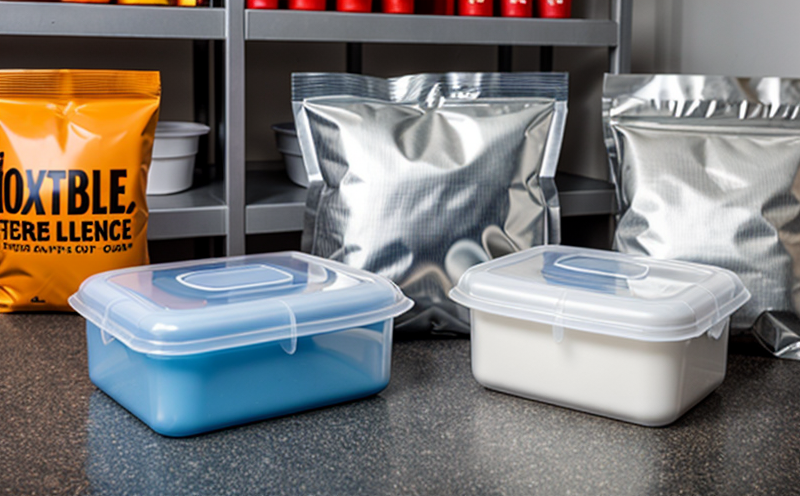ASTM D882-12 Tensile Elongation at Break
The American Society for Testing and Materials (ASTM) D882-12 standard test method is a critical tool in the field of flexible packaging testing. This method evaluates the tensile elongation at break, which is essential for understanding the mechanical properties of materials used in flexible packaging products.
Tensile elongation at break measures how much a material can stretch before it breaks. This property is crucial because it provides insights into the flexibility and durability of the packaging film. The ASTM D882-12 test focuses on three key parameters: tensile strength, modulus of elasticity (tensile modulus), and percent elongation at break.
For flexible packaging films, these properties are vital for ensuring that the material can withstand the stresses encountered during manufacturing, handling, and end-use. The ASTM D882-12 test is particularly important in industries such as food packaging, where the integrity of the film is critical to preventing contamination and maintaining freshness.
The test involves clamping a specimen between two grips that move apart at a constant rate. Tensile elongation at break is determined by measuring the length of the specimen before and after it breaks under applied load. This measurement provides valuable data on the material's ability to stretch without breaking, which is directly related to its flexibility.
The tensile properties measured in this test are influenced by several factors including polymer type, film thickness, additives, processing conditions, and environmental factors such as temperature and humidity. Understanding these variables helps manufacturers optimize their formulations for better performance and reliability.
ASTM D882-12 is widely used across various sectors, particularly in the packaging industry where flexibility is crucial. The test ensures that materials meet specific standards set by regulatory bodies, thereby enhancing product quality and consumer safety. By adhering to this standard, manufacturers can ensure that their flexible packaging products perform consistently under different conditions.
The ASTM D882-12 method provides a standardized approach for testing tensile properties of thin plastic films and sheets used in flexible packaging applications. This ensures consistency across laboratories and helps maintain high-quality standards in the industry. Compliance with this test is essential for any company involved in the production, distribution, or sale of flexible packaging materials.
Understanding the parameters measured by ASTM D882-12 can help stakeholders make informed decisions regarding material selection and process optimization. It also aids in identifying potential issues early on, ensuring that products meet required specifications before they reach the market.
Why It Matters
The importance of tensile elongation at break cannot be overstated, especially for flexible packaging materials used in various sectors. This property directly influences the performance and longevity of packaging films across different applications. By ensuring that materials meet strict standards like ASTM D882-12, manufacturers can enhance product quality while maintaining compliance with regulatory requirements.
The tensile properties measured by this test are vital for several reasons:
- Enhanced Product Quality: Understanding the flexibility and durability of packaging films ensures that products remain intact during transportation and storage.
- Improved Consumer Safety: Ensuring that materials meet rigorous standards helps prevent contamination, leaks, or other issues that could compromise product integrity.
- Regulatory Compliance: Adhering to ASTM D882-12 guarantees that packaging products comply with relevant regulations and industry best practices.
- Economic Efficiency: By optimizing material properties through proper testing, companies can reduce waste and improve overall efficiency in their production processes.
In summary, the ASTM D882-12 test plays a crucial role in maintaining high standards of quality and safety within the flexible packaging industry. It helps manufacturers develop robust materials that meet both functional requirements and regulatory expectations.
Benefits
The benefits of adhering to ASTM D882-12 extend beyond ensuring compliance with industry standards; they also contribute significantly to operational efficiency, product quality, and customer satisfaction. Here are some key advantages:
- Consistency in Material Performance: By standardizing the testing method, manufacturers can achieve consistent results across different batches of materials.
- Better Product Design: Understanding tensile properties allows for more informed decisions about material selection and design optimization.
- Increased Customer Trust: Meeting stringent quality standards builds trust among customers who value reliability and safety in their packaging choices.
- Competitive Advantage: Demonstrating commitment to high-quality materials can set your brand apart from competitors, enhancing market position.
- Cost Savings: Ensuring optimal material performance reduces waste, minimizes rework, and lowers long-term costs associated with subpar products.
- Eco-Friendly Solutions: By choosing compliant materials, companies contribute to environmental sustainability efforts, aligning with growing consumer demand for eco-friendly packaging solutions.
In essence, the ASTM D882-12 test method is more than just a regulatory requirement—it's an essential tool for driving innovation and excellence in flexible packaging design and manufacturing.
Environmental and Sustainability Contributions
- Material Efficiency: By optimizing the tensile properties of materials through thorough testing, companies can reduce waste during production processes. This leads to more efficient use of resources and lower environmental impact.
- Better Recycling Potential: Understanding how packaging materials behave under stress helps design products that are easier to recycle at the end of their lifecycle.
- Reduced Energy Consumption: High-performance materials can contribute to energy savings by improving insulation properties, which is particularly beneficial in food packaging where temperature control is crucial.
- Lower Carbon Footprint: Through improved material performance, companies can reduce the overall carbon footprint associated with their products and operations.
Incorporating ASTM D882-12 into sustainable practices not only enhances product quality but also supports broader environmental goals. By focusing on these aspects, businesses contribute positively to global efforts aimed at reducing waste and promoting recycling initiatives.





